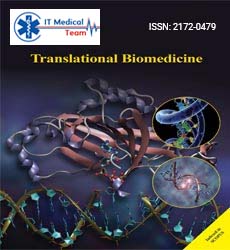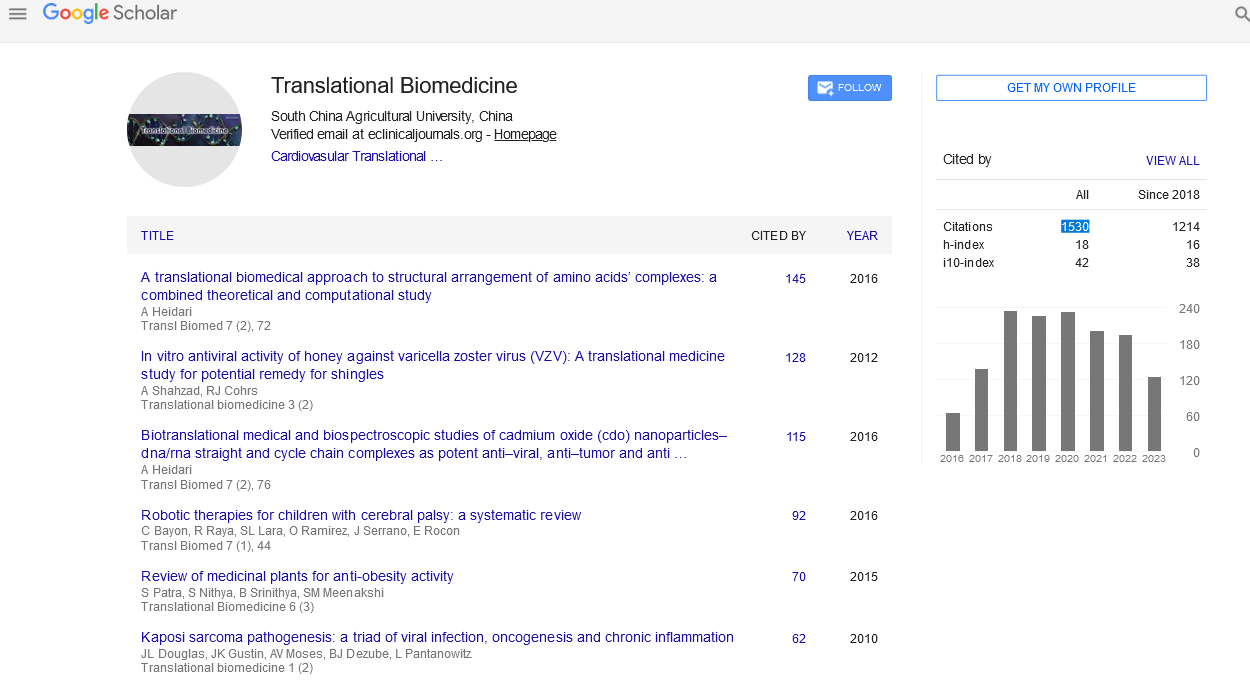Mini Review - (2023) Volume 14, Issue 4
Adoption of Drug Metabolizing Enzyme Genetic Testing by Clinicians
Walt Phillips*
Department of Translational Biomedicine, Canada
*Correspondence:
Walt Phillips, Department of Translational Biomedicine,
Canada,
Email:
Received: 01-Jul-2023, Manuscript No. iptb-23-13995;
Editor assigned: 03-Jul-2023, Pre QC No. iptb-23-13995(PQ);
Reviewed: 17-Jul-2023, QC No. iptb-23-13995;
Revised: 21-Jul-2023, Manuscript No. iptb-23-13995(R);
Published:
28-Jun-2023
Abstract
Before starting a medication, PGx looks at how different people's drug metabolizing enzymes are from one another. As a result, adverse events caused by toxicity and the metabolism of the patient can be avoided. This paper looks at two different uses: a genetic test of the CYP 2C9 enzyme and the Thiopurine methyltransferase gene before beginning mercaptopurine drug therapy and before administering the anticoagulant warfarin. According to the biomedical literature, barriers to PGx have limited clinician experience. A lack of prospective clinical trials, legacy business models between the pharmaceutical industry and physicians, inadequate regulatory oversight, payer reimbursement practices, and physician habits are among these. PGx is unlikely to see widespread use until these issues are addressed. The most significant obstacles to clinician adoption are unproven utility and ingrained business models.
INTRODUCTION
A 2008 article published by the Society for Experimental
Biology and Medicine listed “improved patient outcomes,
lower drug development cost, faster drug development
timelines, and lower drug spending” as likely consequences
of personalized medicine [1]. In this paper I examine the
factors that may be preventing PGx from realizing its
potential. Patient safety is used as a frame of reference when
examining the possible barriers. Though the pharmaceutical
industry is a very large and at times an extremely profitable
industry, drug therapy is ineffective in from of therapeutic
areas. For example, at the high end of the range, psychiatric
drugs may be effective in up to only 62% of patients [2].
Much more dismal is the low end of the range where cancer
and Alzheimer patients are treated with drug therapy that
is beneficial in only 25–30% of cases. Drug therapy’s
lack of efficacy may be partially due to inter-individual
variability of drug response. Unfortunately, due to this
variability, patients all too common experience adverse
drug reactions, sometimes resulting in life-threatening
situations [3]. For the purposes of this paper, I use a
short form for personalized medicine, PGx, as the terms
pharmacogenomics and pharmacogenetics are commonly
used in the same context. Within the biomedical literature,
the definitions tend to zero in on the common issue of
genetic variability to drug response and related topics such
as metabolism and patient safety [4]. In their 2004 paper
from pharmacogenetics to personalized medicine, Frueh
and Gurwitz define pharmacogenetics as “the study of
inter-individual differences in drug response due to genetic
variations. They define pharmacogenomics as “the genomewide
analysis of genetic determinants of drug efficacy and
toxicity, including the identification of drug targets as a
result of such studies”. Pharmacogenetics has two forms,
safety and efficacy. Efficacy pharmacogenetics predicts drug
response.4 Here we are concerned with pharmacogenetics
for preventing adverse drug reactions (ADRs), that is to
say, safety pharmacogenetics [5]. Research in the field
has increased greatly. PubMed citations for the term
pharmacogenomics were 191 in 2000, in 2004 were 598
and increased to 8,638 at the time of writing this paper. In
March 2007, a Medline search for publications containing
the term pharmacogenetics or pharmacogenetics* yielded
4,985 hits. The same search at the time of writing yielded
7,438 hits. When a drug does not provide the patient with
the normal drug effect, but rather the patient experiences
an unwanted effect, that is an adverse drug reaction (ADR)
[6].Taking some drugs, with efficacy that is suboptimal
to begin with, can frequently result in unintended consequences. These consequences have implications for
the patient, for the health care system, for provider hospitals
and clinicians, and for the pharmaceutical industry. ADRs
cost the U.S. health system billions of dollars annually and
are believed be one of the leading causes of death in the
United States each year [7].1,3 In 2001, 2.2 million people
were affected by ADRs resulting in an annual cost in excess
of $177 billion. Studies have suggested that ADRs account
for approximately 7% of hospital admissions and 100,000
deaths annually. Drug pharmacokinetics is concerned
with metabolism, the means by which a drug is broken
down within the body. As pharmacogenetics focuses on
genes that drive drug metabolism, pharmacokinetics is
the core of drug response [8]. An enzyme is made by a
gene or a combination of genes. Diagnostic tests can
identify the various forms of these enzymes.2 Many ADRs
are due to the effect of cytochrome P450 enzymes on
metabolism.9 The cytochrome P450 enzyme, CYP2D6,
for example, metabolizes over 60 commonly used drugs
such antiarrhythmic, antihypertensive and analgesics. For
many drugs, there exist patients that are poor metabolizers
(PM), intermediate metabolizers (IM), and ultra-rapid
metabolizers (UM). The risk of toxicity may increase for
poor and intermediate metabolizers whereas for ultrapid
metabolizers, these patients may require higher than normal
doses for a therapeutic effect [9]. It is not just PM patients
that face potential danger. UM patients, in particular for
certain cancer drugs, must be identified so as to ensure
that therapeutic drug levels are maintained. Nearly 60%
of the most frequently cited drugs in ADR studies were
metabolized by at least one enzyme with a variant, or
allele, causing poor metabolism. Some important ADR
examples stemming from gene-drug combinations include
codeine and the cytochrome P450 2D6 gene (CYP2D6),
mercaptopurine drugs and the TPMT gene, fluorouracil
and the DPD gene, irinotecan and the UGT1A1 gene, and
phenytoin, warfarin and the CYP2C9 gene [10].
Barriers
Payers are unlikely to pay for PGx tests, regardless of how
expensive they are. The need for payers to ensure that
plan members reap the benefits of their contributions is a
recurring theme. Quarterly pressure to report higher sales
and profits motivates insurers, particularly publicly traded
ones. When a subscriber may not be submitting claims
related to the PGx test to the same insurer, whether due
to job-related attrition or otherwise, it may be difficult
for an insurer to subsidize the cost of the test. Up to this
point, payers have not been persuaded that PGx offers great
worth. Due to a perceived lack of efficacy, both clinicians
and payers are reluctant to adopt PGx. The prospective
randomized clinical trial is the gold standard for evidencebased
medicine for forward-thinking clinicians who want
to practice personalized medicine. Sadly for advocates
of PGx, the majority of the evidence has come from retrospective, non-randomized studies or case reports with
inherent bias. The PharmGKB Knowledge Base initiative
has curated a number of relevant genotype-phenotype
associations that have been documented, despite the fact
that clinical trials are lacking. The majority of clinically
relevant associations, on the other hand, are complex and
polygenic, whereas almost all associations to this point have
been monogenic.3 Payers have suggested that PGx studies
should include control groups that receive standard or
usual care rather than the PGx diagnostic. In doing as such,
the payers would be more sure concerning whether the
new expenses with PGx would be pretty much than what
they have been paying. A significant obstacle to clinician
adoption of PGx is physician behavior, whether based on
genetic knowledge, practice guidelines, or alternatives to
personalized medicine. It is challenging for clinicians to
keep up with the rapid expansion of genetic knowledge.
How clinicians can use genetics in practice to improve
patient care might be a more reasonable challenge. Most
of the time, doctors don't know enough about PGx to give
the right advice to patients. When treating patients based
on their disease susceptibility and genetics-driven drug
response, PGx-based decision support might be used in the
future. PGx diagnostics will need to be added to practice
guidelines. In the Unified Realm, despite the fact that PGx
has been taken on to a little degree inside specific claims
to fame, there is irregularity of training rules for TPMT
testing, for instance. Although this important PGx test
could be beneficial to dermatologists, gastroenterologists,
and rheumatologists, only the British Association of
Dermatologists, the association of dermatologists, has
recommended measuring TPMT prior to treatment for all
dermatological conditions before prescribing azathioprine
in the United Kingdom. Practice guidelines are unlikely
to change significantly without evidence, whether in the
form of prospective randomized clinical trials or otherwise,
just like payer reimbursement. Because they have already
successfully implemented alternatives to personalized
medicine, clinicians may be biased. Although not ideal,
phenotypic testing for TPMT activity levels is a proxy for
genotype, as previously mentioned.
CONCLUSION
Therefore, patient safety is not the easy win that many had
hoped personalized medicine would be. However, things
are not over. Pharmaceutical companies and payers may
be motivated to assist in removing these obstacles by the
early successes of PGx test manufacturers. Databases that
link ADRs to DNA samples, such as those maintained by
the International Serious Adverse Events Consortium, may
serve as the foundation for overcoming some of the primary
financial obstacles outlined earlier. Clinician review
investigations of perspectives towards and familiarity with
customized medication might give helpful data to help
with defeating doctor propensities.
REFERENCES
- Aspinall MG, Hamermesh RG. Realizing the promise of personalized medicine. Harv Bus Rev. 2007; 85(10):108–17. 165.
Indexed at, Google Scholar
- De Leon J. Pharmacogenomics the promise of personalized medicine for CNS disorders. Neuropsychopharmacology. 2009; 34(1):159–172.
Indexed at, Google Scholar, Crossref
- Manolopoulos VG. Pharmacogenomics and adverse drug reactions in diagnostic and clinical practice. Clin Chem Lab Med. 2007; 45(7):801–814.
Indexed at, Google Scholar, Crossref
- Bakker JA, Drent M, Bierau J. Relevance of pharmacogenetic aspects of mercaptopurine metabolism in the treatment of interstitial lung disease. Curr Opin Pulm Med. 2007; 13(5):458–463.
Indexed at, Google Scholar, Crossref
- Madadi P, Ross CJ, Hayden MR, et al. Pharmacogenetics of neonatal opioid toxicity following maternal use of codeine during breastfeeding: a case-control study. Clin Pharmacol Ther. 2009; 85(1):31–35.
Indexed at, Google Scholar, Crossref
- Hill CE, Duncan A. Overview of pharmacogenetics in anticoagulation therapy. Clin Lab Med. 2008; 28(4):513–524.
Indexed at, Google Scholar, Crossref
- Flockhart DA, O'Kane D, Williams MS, et al. Pharmacogenetic testing of CYP2C9 and VKORC1 alleles for warfarin. Genet Med. 2008;10(2):139–150.
Indexed at, Google Scholar, Crossref
- Seidman EG, Furst DE. Pharmacogenetics for the individualization of treatment of rheumatic disorders using azathioprine. J Rheumatol. 2002; 29(12):2484–2487.
Indexed at, Google Scholar
- Deverka PA, McLeod HL. Harnessing economic drivers for successful clinical implementation of pharmacogenetic testing. Clin Pharmacol Ther. 2008; 84(2):191–193.
Indexed at, Google Scholar, Crossref
- Owen RP, Klein TE, Altman RB. The education potential of the pharmacogenetics and pharmacogenomics knowledge base (PharmGKB). Clin Pharmacol Ther. 2007; 82(4):472–475.
Indexed at, Google Scholar, Crossref





